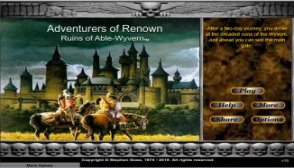Role Playing Game (RPG) Mechanics
Character development and integration.
An RPG Adventure game's mechanics seems simple enough; you create some quests, build a destination lair, generate character avatars for gamers and off they go!? The problem with “RPG” games is that they creation intensive!
A role-playing (RPG) Adventure games started as a table-top game and rapidly migrated onto computer video consoles. This game genre involves guiding an avatar through an adventure story, characterized by random level generation, tile-based graphics and sometimes ending in the avatar’s permanent death. Typical popular examples of this game mechanics are the Adventurers of Renown™ game series, multi-user dungeons (MUD), "dungeon divers", and Roguelike games.
Historically, this game genre comes from the 1970s “Chain Mail” game rules supplement and rapidly grew into the legendary Dungeon & Dragons table-top game, turn-based gameplay. Challenges, quests, and riddles are presented. Computer or console adventure games initially featured text input and little to no graphics — an interactive fiction. Afterwards, graphical adventures became more prominent and text input was replaced by a limited number of icons/menus with verb commands. Two distinct sub-genres of adventure games are Western-style adventures (also referred to as puzzle-solving adventure) and Japanese adventures, which typically have no puzzles and minimal interaction. Visual novels are traditionally also considered a sub-genre of adventure games.
Phaser Game Starter Kit Collection on LeanPub.com: for more details and game rules.
Copyright © 2017, Stephen Gose LLC.
All rights reserved.

